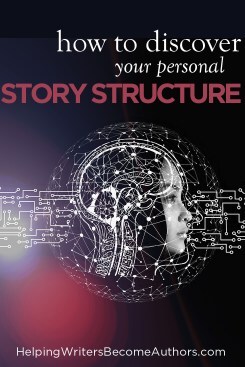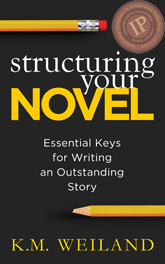Making Story Structure Your Own
 Over the past decade, the term “story structure” has largely come to refer to plot points and beat sheets. When writers start talking about structure, many of us assume they’re talking about the specific and even archetypal shape of story—the rise and fall of plot, the causal balance of action and reaction, the transformational journey of the character.
Over the past decade, the term “story structure” has largely come to refer to plot points and beat sheets. When writers start talking about structure, many of us assume they’re talking about the specific and even archetypal shape of story—the rise and fall of plot, the causal balance of action and reaction, the transformational journey of the character.
Certainly, this is how I think of story structure. Indeed, as regular readers know, much of what I discuss on this site is focused on examining, breaking down, and positing the working parts and patterns found within stories. By this definition, story structure (and its related studies such as character arc) can be wildly exciting since it seems to reveal hidden codes and secrets from out of the body of human storytelling. As writers, this exploration gives us the opportunity to translate our gut understandings of what makes a “good story” into specific and relatable theories. It allows us to look beneath the trappings of stories to the deeper stories underneath, and, more practically, it allows writers to problem-solve our own stories more logically and rationally.
What I talk about on this site and in my books is just my interpretation of story structure. It’s based both on my own experience as a reader and writer, and also on the resonance I’ve felt in response to the insights of many writers and teachers who have come before and who walk beside me. But, again, their insights are also just their interpretations of story structure.

Wild Mind by Natalie Goldberg (affiliate link)
“Structure,” in fact, need not (and didn’t always) explicitly apply to meta discussions of plot mechanics and timing. I was reminded of this in reading Natalie Goldberg’s quirky and wonderful diary of the writing life, Wild Mind (published in 1990). At one point, she offers sound advice on “structure”:
If you want to write a novel, read lots of novels. See what structure the writers have set up for themselves. Look at the length of chapters, who tells the story, what the writers zoom in on, what they leave out. But then you have to tell your own story. What works for you? The structure Mark Twain used to write in is not necessarily the one for you. You are alive now. You can be affirmed and learn from some of Twain’s moves, but you are a different person with your own story to tell.

Structuring Your Novel (Amazon affiliate link)
When I hear her use the word “structure,” my brain naturally fills in my own personal definition of the word. To me, “structure” means three acts, eight major plot points, and the possible variations of about five different primary character arcs. But however useful that application of the word, it is in itself tremendously limited.
Of course structure is more than just plot beats and timing. By its dictionary definition, structure is a “system of parts” on which something is “built or erected.” So even beyond the varied approaches to structure itself, of course structure may also refer to what I tend to consider the more aesthetic, but equally important, decisions that Goldberg references regarding pacing, POV, and framing, among others.
I don’t bring this up to confuse the issue. Whenever I talk about “structure,” it’s always probably going to be about plot shape and timing. But Goldberg’s musings were first and foremost a reminder to me of how personal my interpretation of story structure is—and, by extension, how personal every writer’s interpretation is.
What It Means to Make Story Structure Your OwnGoldberg prefaced the previous quote by musing:
We should use a structure but make it our own. In other words, each time we write something, we reinvent that structure to fit ourselves and what we want to say. This is not arrogance. We honor structure, but we don’t become frozen by an old one. [An interior designer] couldn’t take down all the walls. The roof would have fallen in on him. But if he was working on a house with a baby room, and the new owners didn’t have a baby, he could reshape that room into another space.
Now, I will note that Goldberg wrote this while she was still working through her first novel. Later on, she acknowledges the primary problem with the book’s first draft was that it was “plotless.” So I daresay she had not yet explored the more technical understandings of story structure, which writers of thirty years later now eat for breakfast. And perhaps this was why she used “structure” as a looser term. She does not seem to be talking about “reinventing that structure” in the sense of coming up with a system that completely replaces the Three-Act structure or its equivalents.
But I think her point is still worth pondering.
It’s true that story structure is one of the cornerstones of story theory. And when approached logically, story structure can seem pretty scientific, objective, and inarguable. But even though the essence of story theory is based on the search for universal (or at least prevalent) patterns within storytelling, every writer’s interpretation and application of these patterns will be subjective, personal, and unique.
This is true when it comes to the type of structure writers identify with, how they interpret it, and even how they define the word “structure” itself.

Creating Character Arcs (Amazon affiliate link)
Certainly, it is true of my own approach to structure. What I teach here on this site and in books such as Structuring Your Novel and Creating Character Arcs is ultimately just my approach. It is the understanding of structure “made my own … to fit [myself] and what [I] want to say.” It is what I have gathered from the story structures of others, pieces that have resonated with me and that have fit within my own personal cosmology of story theory.
When I was younger and stupider, I may have thought, “this is the way to do it.” But now I just think, “this is the way I do it.”
So the real question here is: what’s the way you do it?
5 Questions to Help You in Making Story Structure Your OwnYour story structure might look a lot like mine, or John Truby’s, or Michael Vogler’s. Or not.
Regardless, it is yours. Or should be.
However much we harp on form and style in writing, there is only one metric that matters and that is whatever works. Story theory is nothing more than the examination of what works in an attempt to explain and perhaps replicate it. No one writing teacher or writer has the corner on those explanations or replications. We’re all learning from each other in an endless spiral of growth.
The only right way for you to write a story is your way. Naturally, that way is a process of finding what we resonate with and throwing away what we do not—and perhaps most crucially, learning to listen to ourselves enough to know the true difference. Whatever results is your contribution to the larger revealed study of story theory and structure.
So here are a few questions you can ask yourself to help you in making story structure your own.
1. What Do You Think Works?If the only rule of writing that actually matters is “whatever works,” then what do you think works? What do you feel, deep in your bones, is the essence of story? What is the foundation of a successful plot? What makes characters and their journeys interesting? Which bits of writing advice and structural theories resonate with you? What is the secret sauce that makes your favorite stories work for you?
2. What Patterns Keep Popping Out to You in Other People’s Stories?When we talk about “writing rules,” we’re pretty much always talking about emergent patterns. If somebody suddenly realizes that every great story ever uses the word “be-bop-a-Lula” (that’s a word, right?), then that would be the recognition of a pattern. Next thing you know we’re all telling our spellcheckers to allow “be-bop-a-Lula” and writing excited posts to share the news with our fellow scribes. So what do you see? What patterns can you see emerging from successful story to successful story?
3. What Patterns Keep Popping Out in Your Stories?How about we get even more personal and just take the fast train straight to your own unconscious. If you’ve written (or imagined) more than one story, what patterns can you see there? What are the scenes, characters, or moments that give your heart a little zing? What are the pieces that are making this story work? Right here you’ll find your most personal understanding of structure.
4. What Do You Think Doesn’t Work?Sometimes even more telling than identifying what works is identifying what doesn’t—both in your own stories and in those of other people. It can help to start with a basic theory about what you think does work, then examine any jarring notes to see if they’re jarring because they’ve strayed from your posited pattern of perfection. Ultimately, the whole purpose of story theory as a writing tool is to help us identify what doesn’t work and eliminate it from the process.
5. Why? Why? Why?Every time you ask one of the previous questions, ask this one as least three times. Why does something work? Why does something not work? Why does it seem like certain patterns are emerging? Why might you (or others) be imagining a pattern where it really doesn’t exist? Underneath the why is where you’ll find not just your own take on story structure, but the deeper understanding that will allow you to build upon it (and perhaps share it with the rest of us).
***
At another point in Wild Mind, Goldberg shared that one of the reasons she wanted to move on from poetry to try writing her first novel was that novel-writing was more of a practice and a process. She said:
Poetry is about the divine; a novel is about work and learning to behave.
I take this to mean that the experience of writing poetry is about capturing that one flash of inspiration, while writing long-form fiction is about patiently building a structure upon which to stand. The “learning to behave” bit might implicitly refer to recognizing the necessity of a structure. But certainly it also means learning to take responsibility for our own understanding of story. At the end of the day, no one can tell us the right way to write except ourselves.
Wordplayers, tell me your opinions! How have you structured your latest story? Tell me in the comments!Click the “Play” button to Listen to Audio Version (or subscribe to the Helping Writers Become Authors podcast in Apple Podcast or Amazon Music).
___
Love Helping Writers Become Authors? You can now become a patron. (Huge thanks to those of you who are already part of my Patreon family!)The post Making Story Structure Your Own appeared first on Helping Writers Become Authors.




